Blog & Latest Updates
Fly Fishing Articles
Insects by Common Name


Quick bug collecting and gear test trip
I was out in the Issaquah Alps doing some puppy training yesterday and decided to bring my bug-collecting stuff along. Mostly it was an excuse to get more practice with my new microscope and test out a new system for holding bugs I've sorted to photograph.
Previously, I've had some sensitive specimens quickly die after being sorted into their own separate containers or compartments, either because the water warms up more quickly in the compartments or the oxygen runs out. This leads to specimens that aren't in ideal shape for photos. To solve the problem, I drilled holes in an ice cube tray and gorilla glued some little squares of 250-micron Nitex mesh (drift sampling net material) to the outside. Then I stick the whole thing in a tub of aerated water with a freezer block. This allows me to separate different types of bugs into lots of compartments, while still having them aerated and cooled from a common, larger reservoir of water.

It worked great. Some typically fragile Baetids and Heptageniids stayed in good shape for a very long time, more than long enough to take photos. I didn't photograph any of the Heptageniids, though, because they were Cinygmula and Rhithrogena nymphs for which there are no species keys available.
My favorite new addition was Claassenia sabulosa, a very pretty golden stonefly nymph.

There were also a lot of Hesperoperla pacifica nymphs in the sample, but I already have good photos of those.
Closeup insects by Troutnut from Holder Creek in Washington
Claassenia sabulosa (Golden Stone) Stonefly Nymph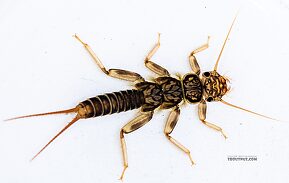 View 11 PicturesThis striking golden stonefly is the first of its species I've had the chance to photograph.
View 11 PicturesThis striking golden stonefly is the first of its species I've had the chance to photograph.
 View 11 PicturesThis striking golden stonefly is the first of its species I've had the chance to photograph.
View 11 PicturesThis striking golden stonefly is the first of its species I've had the chance to photograph.Collected April 12, 2021 from Holder Creek in Washington
Added to Troutnut.com by Troutnut on April 13, 2021
Added to Troutnut.com by Troutnut on April 13, 2021
Taenionema (Willowflies) Stonefly Nymph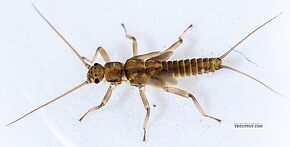 View 11 PicturesThis specimen was the only one of its kind in my kick net sample from this small creek. At first I thought it was Nemouridae, but it's not. Unfortunately, there is no species key available for Taenionema nymphs. Potential species found in Washington include nigripenne, oregonense, pacificum, and pallidum.
View 11 PicturesThis specimen was the only one of its kind in my kick net sample from this small creek. At first I thought it was Nemouridae, but it's not. Unfortunately, there is no species key available for Taenionema nymphs. Potential species found in Washington include nigripenne, oregonense, pacificum, and pallidum.
 View 11 PicturesThis specimen was the only one of its kind in my kick net sample from this small creek. At first I thought it was Nemouridae, but it's not. Unfortunately, there is no species key available for Taenionema nymphs. Potential species found in Washington include nigripenne, oregonense, pacificum, and pallidum.
View 11 PicturesThis specimen was the only one of its kind in my kick net sample from this small creek. At first I thought it was Nemouridae, but it's not. Unfortunately, there is no species key available for Taenionema nymphs. Potential species found in Washington include nigripenne, oregonense, pacificum, and pallidum.Collected April 12, 2021 from Holder Creek in Washington
Added to Troutnut.com by Troutnut on April 13, 2021
Added to Troutnut.com by Troutnut on April 13, 2021
Male Baetis bicaudatus (BWO) Mayfly Nymph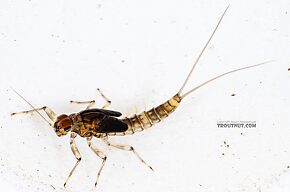 View 7 PicturesThis specimen was collected along with a female which was quite a bit larger, different in color, but otherwise seemed the same morphologically.
View 7 PicturesThis specimen was collected along with a female which was quite a bit larger, different in color, but otherwise seemed the same morphologically.
 View 7 PicturesThis specimen was collected along with a female which was quite a bit larger, different in color, but otherwise seemed the same morphologically.
View 7 PicturesThis specimen was collected along with a female which was quite a bit larger, different in color, but otherwise seemed the same morphologically.Collected April 12, 2021 from Holder Creek in Washington
Added to Troutnut.com by Troutnut on April 13, 2021
Added to Troutnut.com by Troutnut on April 13, 2021
Female Baetis bicaudatus (BWO) Mayfly Nymph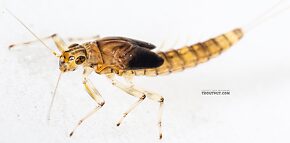 View 12 PicturesI collected this one along with a male that was quite a bit smaller but equally ready to emerge in mid April.
View 12 PicturesI collected this one along with a male that was quite a bit smaller but equally ready to emerge in mid April.
I spent (Spent: The wing position of many aquatic insects when they fall on the water after mating. The wings of both sides lay flat on the water. The word may be used to describe insects with their wings in that position, as well as the position itself.) quite a while on the identifications, because they really don't look very much like the Baetis bicaudatus nymph I caught last year in Idaho. However, the presence of hind wing pads (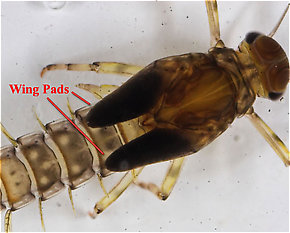 Wing pad: A protrusion from the thorax of an insect nymph which holds the developing wings. Black wing pads usually indicate that the nymph is nearly ready to emerge into an adult.) rules out Acentrella turbida, the lack of a fringe of long setae (Seta: Little hairs on insects.) on the tibiae (
Wing pad: A protrusion from the thorax of an insect nymph which holds the developing wings. Black wing pads usually indicate that the nymph is nearly ready to emerge into an adult.) rules out Acentrella turbida, the lack of a fringe of long setae (Seta: Little hairs on insects.) on the tibiae (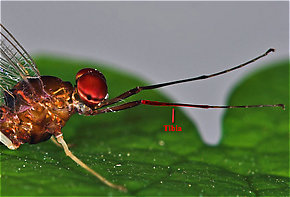 Tibia: A middle segments in the leg of an insect, located between the femur and the tarsus.) rules out Acentrella insignificans, range rules out Heterocloeon and Iswaeon, and the thumb-like projection on the labial palp (
Tibia: A middle segments in the leg of an insect, located between the femur and the tarsus.) rules out Acentrella insignificans, range rules out Heterocloeon and Iswaeon, and the thumb-like projection on the labial palp (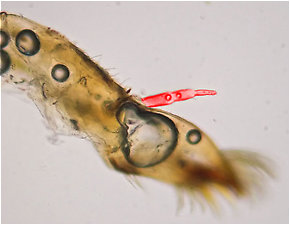 Palp: A long, thin, often segmented appendage which can protrude from certain insect mouth parts such as the maxillae. Also known as the < />palpus.) points to Baetis. Thus, Baetis bicaudatus is a fairly confident ID, and it's not too surprising that it looked different from my previous specimen because bicaudatus is thought to be a species complex with multiple types that haven't been fully sorted out yet.
Palp: A long, thin, often segmented appendage which can protrude from certain insect mouth parts such as the maxillae. Also known as the < />palpus.) points to Baetis. Thus, Baetis bicaudatus is a fairly confident ID, and it's not too surprising that it looked different from my previous specimen because bicaudatus is thought to be a species complex with multiple types that haven't been fully sorted out yet.
The microscope pictures for this specimen aren't from the same exact nymph, but a mixture of a few others of the same kind that I didn't mind dissecting.
 View 12 PicturesI collected this one along with a male that was quite a bit smaller but equally ready to emerge in mid April.
View 12 PicturesI collected this one along with a male that was quite a bit smaller but equally ready to emerge in mid April.I spent (Spent: The wing position of many aquatic insects when they fall on the water after mating. The wings of both sides lay flat on the water. The word may be used to describe insects with their wings in that position, as well as the position itself.) quite a while on the identifications, because they really don't look very much like the Baetis bicaudatus nymph I caught last year in Idaho. However, the presence of hind wing pads (

The wing pads on this final instar Baetidae mayfly nymph are extremely dark.

The tibia of this Isonychia bicolor mayfly spinner is highlighted in red.

The palp on the maxilla of an Ephemerella nymph (detached and photographed under a microscope) is highlighted in red here.
The microscope pictures for this specimen aren't from the same exact nymph, but a mixture of a few others of the same kind that I didn't mind dissecting.
Collected April 12, 2021 from Holder Creek in Washington
Added to Troutnut.com by Troutnut on April 13, 2021
Added to Troutnut.com by Troutnut on April 13, 2021
Most recent comments on this post (latest on top)
| Troutnut | April 16th, 2021, 7:03 pm | |
Administrator Bellevue, WAPosts: 2737 | Yeah, I've taken plenty of photographs of specimens I know I can't identify beyond genus in the past, and I'm sure I will in the future. But I'll probably be a but more selective about them, i.e. favoring distinctive-looking mature specimens, because otherwise I'll just have dozens of nondescript "Cinygmula nymph" nobody's looking at. For now, I'm trying to focus more of my effort on adding taxa I don't have well-represented yet. | |
| Jason Neuswanger, Ph.D. Troutnut and salmonid ecologist | ||
| Millcreek | April 16th, 2021, 11:57 am | |
| Healdsburg, CA Posts: 356 | Nice photos. You should give some thought to photographing species for which keys are unavailable. Even if you can't get past genus you at least have a record and possibly can identify it if someone does come up with a key. Anyway I've really been enjoying the western species you've been photographing. | |
Comment on this post
Top 10 Fly Hatches
Top Gift Shop Designs
Eat mayflies.
Top Insect Specimens
Miscellaneous Sites
Troutnut.com is copyright © 2004-2024 Jason
Neuswanger (email Jason). See my FAQ for information about use of my images.
 privacy policy
privacy policy

